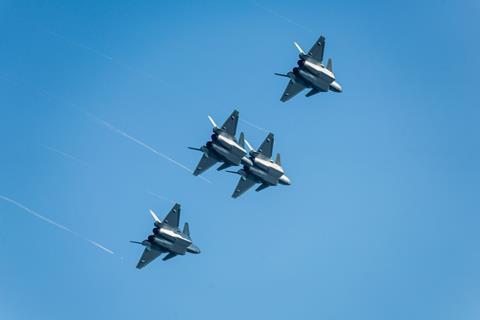Beijing’s efforts to improve domestic aircraft engines are bearing fruit, according to the Pentagon’s most recent report about China’s military.
In its annual report to Congress, the US Department of Defence (DoD) notes that both the Chengdu J-10 and J-20 fighters are switching to the domestically produced WS-10.

“China’s decades-long efforts to improve domestic engine production are starting to produce results with the J-10 and J-20 fighters switching to domestically produced WS-10 engines by the end of 2021,” says the report.
“China’s first domestically produced high-bypass turbofan, the WS-20, has also entered flight testing on the Y-20 heavy transport and will replace imported Russian engines by the end of 2022.”
As with its previous China report in November 2021, the DoD states work is also underway to increase the number of air-to-air missiles the J-20 can carry internally, in addition to equipping the type with thrust vectoring engine nozzles, and installing the higher thrust WS-15.
The Pentagon’s report follows the recent appearance on Chinese state TV of a production standard Shenyang J-15 powered by WS-10s. The appearance of the WS-10 on a carrier-capable jet shows significant confidence in the engine.
In May 2021 a People’s Liberation Army Air Force (PLAAF) J-10C appeared with a WS-10 powerplant and WS-10-powered J-10Cs have also been exported to Pakistan. J-20s powered by WS-10s recently appeared at Airshow China in Zhuhai.
The new report repeats a number of assertions from 2021, namely that the PLAAF is on its way to being a “majority fourth-generation” force in the coming years. It also reiterates the nuclear role for the Xian H-6N bomber, which it contends was operationally fielded in 2020.
“The H-6N-equipped unit very likely is developing tactics and procedures to conduct the PLAAF nuclear mission,” says the DoD.
It adds that work on the developmental H-20 stealth bomber – which will have nuclear and conventional roles – continues.
As with previous reports, the DoD hints at the development of new “medium- and long-range stealth bombers to strike regional and global targets”. This appears to be a reference to Beijing’s mysterious JH-XX tactical bomber programme.
In the report, the DoD also reveals that Beijing is on track to have 1,500 nuclear warheads by 2035, and that its stockpile of nuclear warheads has likely surpassed 400.
“[China] is investing in, and expanding the number of its land-, sea-, and air-based nuclear delivery platforms and constructing the infrastructure necessary to support this major expansion of its nuclear forces.”






















